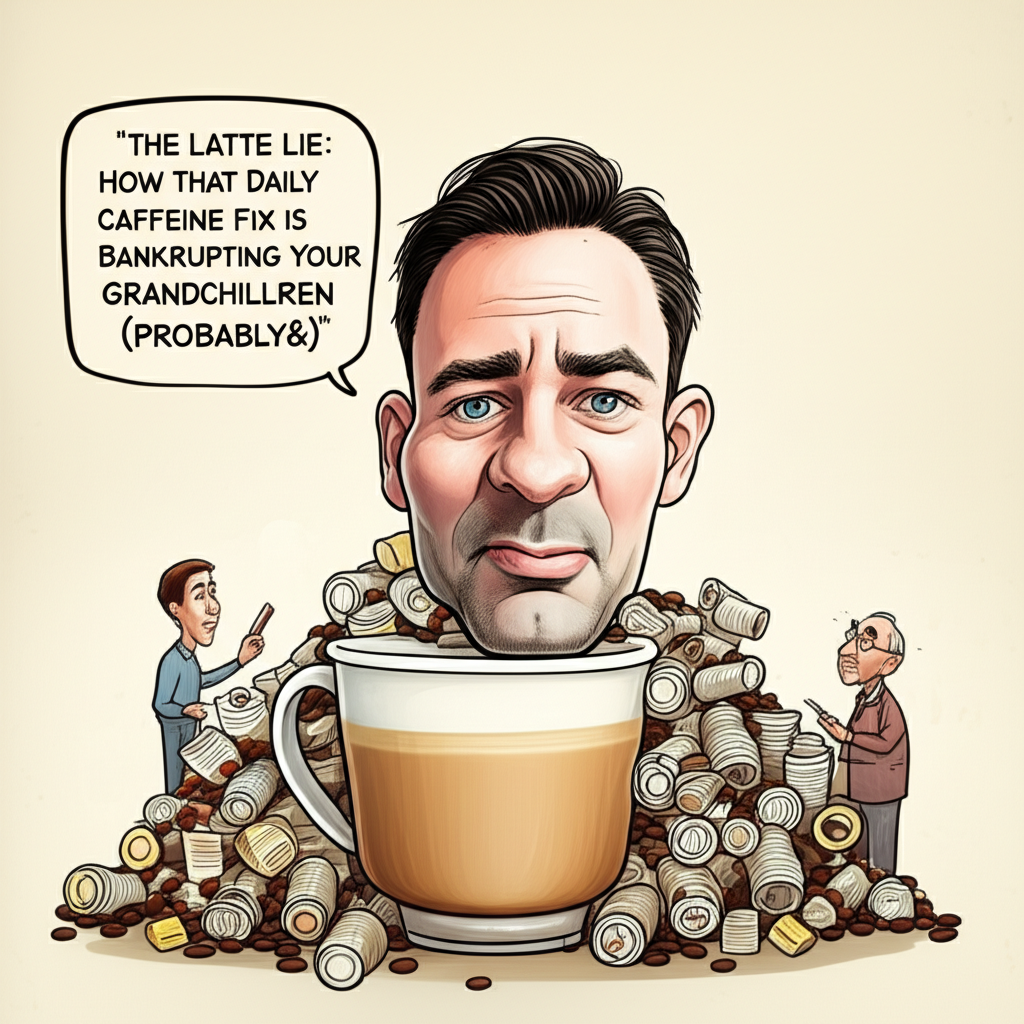
Article 1: "The Latte Lie: How That Daily Caffeine Fix is Bankrupting Your Grandchildren (Probably)"
Headline: Latte-pocalypse NOW: Is Your Morning Brew Dooming Future Generations?
Image: A picture of a ridiculously oversized latte, photoshopped to look like it’s towering over a city skyline.
Body:
We’ve all heard it. The dreaded "Latte Lie." Financial gurus whisper it in hushed tones, your frugal Aunt Mildred shrieks it at Thanksgiving, and even your cat seems to judge you when you come home with a Frappuccino. "That daily latte," they hiss, "is the reason you’ll never own a yacht/mansion/solid gold toilet!"
But is it true? Are we really throwing away our financial futures one foamy cup at a time? Let’s do the math (because who needs fun when you can have compound interest spreadsheets?):
- The Offender: A fancy-pants latte. Let’s say $5 a pop. Because let’s be honest, you’re not getting the gas station special. You need that artisanal, ethically-sourced, fair-trade, unicorn-blessed bean juice.
- The Frequency: Every. Single. Weekday. Because you need it. Without it, you’re just a grumpy, caffeine-deprived husk of a human.
- The Accumulation: That’s $25 a week! $100 a month! $1200 a year! (Suddenly, the yacht dream seems a little less yacht-y and a little more dinghy-ish.)
- The Hypothetical Investment: Now, if you invested that $1200 annually for, say, 40 years, earning a hypothetical 7% return (which is totally guaranteed and not at all subject to market fluctuations, wink wink), you’d have…wait for it… enough to buy a slightly used jet ski! (Or maybe pay off a small portion of your student loans. Let’s be realistic.)
The Verdict: Okay, so maybe your latte habit isn’t single-handedly responsible for the next global financial crisis. But it is a symbol of the insidious creep of small, everyday expenses that slowly drain your bank account. Think of it as death by a thousand sprinkles.
Alternative Solutions:
- Become a Barista: Free lattes! (And the soul-crushing realization that you’re making lattes instead of pursuing your dreams.)
- Embrace Instant Coffee: Taste the freedom (from debt)! (And also, possibly, taste the regret.)
- Invest in a Really, Really Good Coffee Maker: Think of it as an investment in your future. A future filled with slightly less delicious, but significantly cheaper, coffee.
Moral of the Story: Don’t blame the latte. Blame your insatiable desire for overpriced caffeinated beverages. And maybe start clipping coupons. Your grandchildren will thank you. (Probably.)
Article 2: "Cryptocurrency: From Riches to Rags (and Back Again?): A Guide for the Clueless Investor"
Headline: Bitcoin to Bankruptcy: A Beginner’s Guide to Riding the Crypto Coaster (of Doom…or Maybe Success?)
Image: A cartoon rollercoaster with a Bitcoin logo on the front car, plunging dramatically into a pit of despair labeled "Student Loan Debt."
Body:
So, you’re thinking about diving into the world of cryptocurrency? Excellent! You’re either a visionary genius or a gambling addict with a smartphone. Either way, welcome to the party! Just try not to lose your shirt…or your house…or your sanity.
Cryptocurrency is like the Wild West of finance: unregulated, unpredictable, and populated by a mix of brilliant innovators, shady characters, and guys who wear fedoras indoors. It’s a place where fortunes can be made (and lost) faster than you can say "blockchain."
Here’s what you need to know (before you YOLO your life savings into Dogecoin):
- Understanding the Basics (Sort Of): Cryptocurrency is digital money secured by cryptography. It’s decentralized, meaning no bank or government controls it. Think of it as the rebellious teenager of the financial world, constantly defying authority and doing whatever it wants.
- The Jargon: HODL, FOMO, DeFi, NFTs… it’s enough to make your head spin. Don’t worry, you don’t really need to understand it. Just nod sagely and say things like, "The blockchain is truly disruptive" and "I’m bullish on altcoins." Fake it ’til you make it! (Or lose it all. One of the two.)
- The Risk: Imagine the stock market… on steroids… during a hurricane… while being attacked by a swarm of bees. That’s crypto. Prices can swing wildly in a matter of minutes. One minute you’re planning your early retirement on a private island, the next you’re selling your Beanie Baby collection to pay the electricity bill.
- The FOMO (Fear Of Missing Out): This is the real killer. You see your neighbor bragging about his Bitcoin gains, and suddenly you feel like you’re missing out on the greatest opportunity of your life. Don’t fall for it! Remember, your neighbor also wears socks with sandals.
- The Shady Characters: The crypto world is teeming with scams, rug pulls, and pump-and-dump schemes. If it sounds too good to be true, it probably is. Never invest in anything you don’t understand, and always be skeptical of anyone promising guaranteed returns.
Investing Tips (That May or May Not Be Helpful):
- Only Invest What You Can Afford to Lose: Seriously. This is not a joke. If you’re relying on crypto to pay your rent, you’re doing it wrong.
- Do Your Research (Or Just Google It): Read white papers, follow reputable analysts, and understand the technology behind the cryptocurrency you’re investing in. (Or just watch a few YouTube videos and hope for the best. No judgment.)
- Diversify (Like You Would With Real Investments): Don’t put all your eggs in one digital basket. Spread your risk across multiple cryptocurrencies… and maybe a few actual, tangible assets like, you know, food.
- HODL (If You Dare): HODL is crypto slang for "hold on for dear life." It means resisting the urge to sell when prices crash (which they will). It’s a test of your emotional fortitude. Can you stomach watching your investment plummet by 50% and still maintain a semblance of sanity? If so, you might be a crypto HODLer. If not, stick to index funds.
The Bottom Line:
Cryptocurrency can be exciting, potentially lucrative, and incredibly risky. Approach it with caution, do your research, and never invest more than you can afford to lose. And remember, if you strike it rich, don’t forget to buy your Aunt Mildred a really, really nice latte.
Article 3: "The Budgeting Black Hole: Where Your Money Goes to Die (and How to Escape)"
Headline: Conquering the Couch Monster: Slaying Your Budget Demons (Before They Eat Your Bank Account)
Image: A cartoon monster made of loose change and receipts, devouring a stack of dollar bills.
Body:
Budgeting. The word itself is enough to send shivers down the spines of even the most financially responsible adults. It conjures up images of spreadsheets, deprivation, and a life devoid of joy. But fear not, dear reader, because budgeting doesn’t have to be a soul-crushing experience. It can be… well, let’s just say it can be slightly less painful than a root canal.
The problem is, most people treat budgeting like a restrictive diet. They cut out all the fun stuff, leaving them feeling deprived and resentful. And just like a diet, a restrictive budget is doomed to fail. You’ll eventually cave and binge on takeout and impulse purchases, leaving you feeling even worse than before.
So, how do you create a budget that actually works? Here are a few tips, presented with a healthy dose of sarcasm:
- Track Your Spending (Like a Stalker): The first step is to figure out where your money is actually going. This means meticulously tracking every single expense, from your daily latte (see above) to that impulse purchase of a rubber chicken wearing a tiny hat. You can use a budgeting app, a spreadsheet, or a good old-fashioned notebook. Just be prepared to be horrified by what you find. (Hint: It’s probably Amazon’s fault.)
- Create a Realistic Budget (That You Can Actually Stick To): Don’t try to cut out all the fun stuff at once. Start by identifying your biggest expenses and finding small ways to reduce them. Maybe you can switch to a cheaper phone plan, cancel that gym membership you never use, or start packing your lunch instead of buying it. And for the love of all that is holy, don’t forget to budget for fun! A little bit of pleasure is essential for maintaining your sanity.
- Automate Everything (So You Don’t Have to Think About It): Set up automatic bill payments, transfers to your savings account, and even automatic investments. This will help you stay on track without having to constantly monitor your finances. Think of it as putting your money on autopilot. Just make sure the autopilot is programmed correctly, or you might end up in the Bermuda Triangle of debt.
- Embrace the "Envelope System" (For the Anal Retentive): This involves dividing your cash into envelopes labeled with different categories (groceries, entertainment, etc.). When the money in an envelope is gone, you’re done spending in that category for the month. It’s a great way to visualize your spending and stay within your limits. Just be careful not to lose the envelopes, or you’ll end up with a financial scavenger hunt in your own home.
- Forgive Yourself (When You Mess Up): Everyone makes mistakes. Don’t beat yourself up if you overspend one month. Just learn from your mistakes and get back on track the next month. Budgeting is a marathon, not a sprint. Unless you’re sprinting away from your debt collectors.
The Bottom Line:
Budgeting is not about deprivation. It’s about taking control of your finances and making conscious choices about where your money goes. It’s about prioritizing the things that are important to you and eliminating the things that are not. And it’s about finally conquering that Couch Monster that’s been eating your bank account for years. Now go forth and budget responsibly… or at least try to. Good luck! You’ll need it.
These are just a few examples. The key is to find the humor in the often-stressful world of finance and to use that humor to make the information more palatable and memorable. Remember to keep the tone light, use relatable examples, and don’t be afraid to poke fun at yourself (and the financial industry). Good luck writing your own!


Post Comment